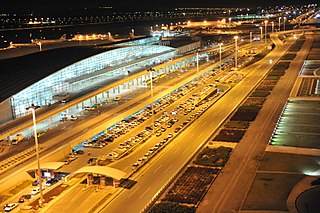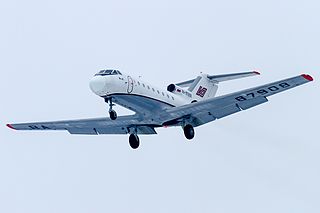
Iran Air, officially known as The Airline of the Islamic Republic of Iran, or before known as The National Airline of Iran, is the flag carrier of Iran, which is headquartered at Mehrabad Airport in Tehran. As of 2024, it operates scheduled services to 72 destinations in Asia and Europe. Iran Air's main bases are Imam Khomeini International Airport and Mehrabad International Airport, both serving Tehran, the capital of Iran. Domestically, Iran Air is commonly known as Homa, which is the name of a mythical Persian phoenix or griffin, and also the acronym of Iran National Airlines in the Persian language. The airline's cargo division, Iran Air Cargo, operates scheduled services internationally using one cargo aircraft.

Tehran Imam Khomeini International Airport is the international airport of Tehran, the capital of Iran. It is located 2 kilometers (1 mi) of Vahnabad and 35 kilometres southwest of Tehran and is named for Ruhollah Khomeini, Iran's first supreme leader. The airport is operated by Imam Khomeini Airport City Company. It covers 13,400 hectares and has two terminals and two runways. All international flights into Tehran are served by the airport, and all domestic flights land at Mehrabad Airport. Imam Khomeini Airport is a hub for multiple airlines. As of the fiscal year ending on 20 March 2019, it ranked third in terms of passenger traffic in Iran.
Kish Airlines is an airline operating from Kish Island, Iran. It operates international, domestic and charter services as a scheduled carrier. Its main bases are Kish International Airport and Mehrabad International Airport, Tehran.
Qeshm Air is an Iranian airline; it has its headquarters in Tehran, Iran and operates scheduled domestic and international passenger services as well as charter flights. The airline was founded in 1993 as Faraz Qeshm Airline.
Saha Airlines is an Iranian airline based in Tehran that operates scheduled domestic flights.

Mehrabad International Airport is an airport serving Tehran, the capital city of Iran. Prior to the construction of the larger Imam Khomeini International Airport in 2007, Mehrabad was Tehran's primary airport for both international and domestic traffic, but now serves only domestic flights. Despite this, in 2016, Mehrabad Airport was the busiest airport in Iran in terms of passengers, handling 16,678,351 passengers in total. The airport is also used by the Government of Iran and is one of the bases of the Iranian Air Force.
Abadan International Airport is situated 12 kilometers away from the city of Abadan, Iran.

Ust-Kut Airport is an airport in Irkutsk Oblast, Russia which is located 9 km north of Ust-Kut. It services short-haul routes and links the town to Irkutsk and Krasnoyarsk.

Gorgan Airport is an international airport in the city of Gorgan, Golestan province, Iran.

Iran Air Flight 291 was a flight from Mashad Airport to Tehran-Mehrabad Airport that crashed on 21 January 1980 during its approach to Tehran-Mehrabad runway 29 in foggy and snowy weather conditions, killing all 128 people on board. At the time, Iran Air Flight 291 was the deadliest aircraft disaster in Iranian history.

Caspian Airlines Flight 7908 was a scheduled commercial flight from Tehran, Iran, to Yerevan, Armenia, that crashed near the village of Jannatabad, outside the city of Qazvin in north-western Iran, on 15 July 2009. All 153 passengers and 15 crew members on board died.

Iran Aseman Airlines Flight 746 was a Fokker F-28 flight of Iran Aseman Airlines operating on the Isfahan–Tehran route in Iran. The flight crashed near the town of Natanz on October 12, 1994, killing all the passengers and crew members.

Ukrainian-Mediterranean Airlines Flight 4230 was a chartered international passenger flight, a Yakovlev Yak-42D operated by Ukrainian UM Airlines, which crashed in 2003.

Sepahan Airlines Flight 5915 was a scheduled domestic passenger flight from Iranian capital Tehran Mehrabad International Airport to Tabas, South Khorasan province, Iran. On 10 August 2014, the HESA IrAn-140 twin turboprop serving the flight crashed shortly after takeoff from Mehrabad International Airport, falling into a boulevard near the Azadi Stadium. Of the 42 passengers and six crew on board, 40 people died.

The 1994 Vanavara air disaster occurred on 26 September 1994 when a Yakovlev Yak-40, operated by Russian regional airliner Cheremshanka Airlines, crashed onto the bank of a river near Vanavara, Russia. All 24 passengers and 4 crew members died.

Aeroflot Flight 1080 was a Soviet domestic passenger flight from Sverdlovsk, Russia, to Dzhambul, Kazakhstan, that crashed at night shortly after takeoff on 7 October 1978. All 38 passengers and crew were killed in the crash which occurred when one of the engines failed due to icing during initial climb out. At the time, the crash was the second worst in the history of the Yakovlev Yak-40, which had entered operational service with Aeroflot just ten years prior.

Iran Aseman Airlines Flight 3704 was a scheduled Iranian domestic passenger flight from Iranian capital Tehran Mehrabad International Airport to Yasuj in southwest Iran. On 18 February 2018, during its approach to Yasuj, the aircraft serving the flight, an ATR 72-212 operated by Iran Aseman Airlines, crashed into Mount Dena in the Zagros Mountains near Noqol village in Semirom county, Isfahan Province. All 66 people on board, including 60 passengers and 6 crew members, were killed.

The 1981 Zheleznogorsk mid-air collision was an accident involving a Yakovlev Yak-40 jet and a Mil Mi-8T helicopter, both operated by the Russian airline Aeroflot, 11 km east of Zheleznogorsk-Ilimskiy Airport, Soviet Union, on 18 September 1981. None of the combined 40 passengers and crew on either aircraft survived.














